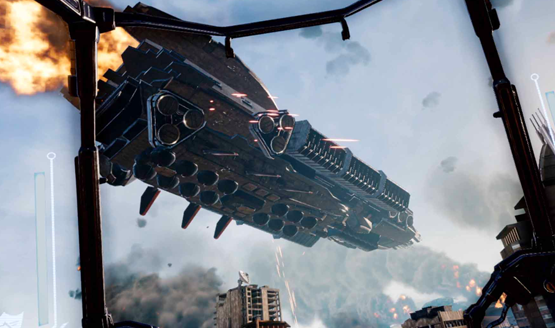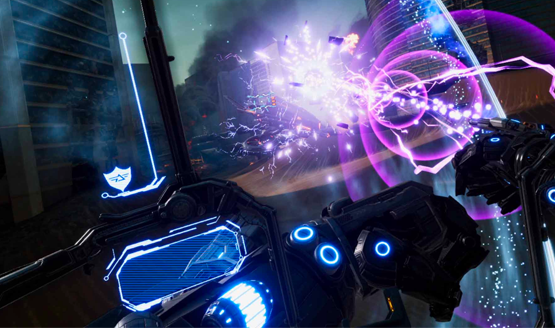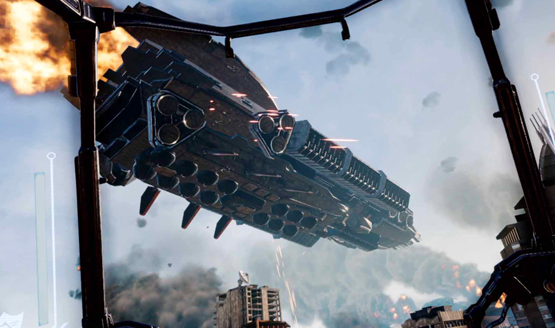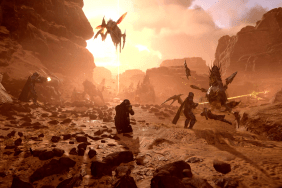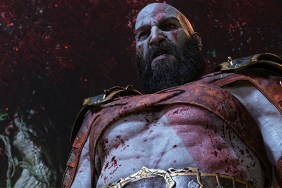I’ve said it before, I’ll say it now, and I will likely say it again: Virtual reality is all about immersion and presence. If you can make the player feel like they are really there and give them some awe-inspiring moments during the gameplay, then VR has achieved its purpose. Much like any medium, there are many different ways that virtual reality can be harnessed to tell a story and deliver interesting gameplay. Skydance Interactive is no stranger to emotionally connecting with their audience, being an arm of Skydance Media that has an incredible resume of films and TV shows under their belt. Archangel stays on this bearing by making the player a pilot of a six-story mech and telling a captivating and emotional story about love, loss, and sacrifice.
“A captivating and emotional story about a guy in a mech?” you ask, or at least I assume you might, considering I wondered the same thing as I started Archangel up. I just wanted to get to blowing stuff up as I piloted a mech, but was surprised to find that being Gabe (or Gabby, if you choose the girl) Walker was about so much more than the kind of destruction a 70-ton machine could cause. I won’t spoil the opening for you here, but just know that how you begin the journey through an apocalyptic landscape in a metal death machine is pretty heart rending, and each mission further evolves Walker’s personality, mission, and story as you interact with your team.
Archangel isn’t full of the cheesy passable voice acting that I was expecting from a VR mech game. Its quality voice and character interactions are both fun and meaningful in a way that helps to advance the narrative and Walker’s mental state. Skydance went so far in wanting to create an immersive story for the player that they tailored it entirely around whether you pick the male or female lead, meaning that players can really immerse themselves in that pilot seat and feel like they are Gabe or Gabby Walker. Archangel is worth a playthrough for the story alone. It may not be the most unique plot narrative, but telling it through VR adds an impassioned edge that separates it from a film or even a non-VR game.
Controlling a Mech
Grabbing a Move in each hand, it was time for the moment I had been waiting for: piloting a mech. Except that I was really only in control of the arms. As the pilot, I was able to use each Move controller to move each of the mech’s massive arms around, balling the hands into fists, firing wrist mounted guns, and activating temporary shields to protect myself from enemy fire. It’s not a 1:1 ratio between your arm movement and that of the robot arms, which does help to ground the player as the pilot rather than the mech itself. It’s possible to use the DualShock 4, and I was impressed with how clean they made the controls no matter which you use, but there’s something special about feeling like you are holding the joysticks that control the arms of a mech.
Archangel is essentially an on rails shooter, with an AI (another great character in the story) controlling the movement. My excitement waned somewhat as I realized I would not be controlling the movement of the mech, but this worry was quickly forgotten. Let me be clear about one thing. Archangel is hard. A combination of assaults from both the air and ground, needing to coordinate temporary shields on each arm, switching between multiple weapon types, and keeping track of which reticle is for which arm makes sure that every encounter is like spinning plates. There were times that I often died without even knowing what hit me. I died multiple times on normal difficulty and can’t imagine making this trek on the hard or permadeath modes.
The difficulty level actually makes the story have a stronger impact, really feeling like you are a small team of fighters going up against the odds. If I was too easily able to overcome all of the challenges that Archangel threw at me, I would have felt that the delivery method of an interactive experience didn’t serve the narrative, as I’m not really supposed to feel like an overpowered god. It struck that perfect balance between demanding gameplay and accessibility, especially after I got into the groove of using every mech function to my advantage.
The ability to upgrade your mech’s capabilities after each mission lends a little bit to the replay value, but a weak trophy list (I was only missing one by the time I finished the game on normal) and no additional challenges beyond the campaign means that Archangel doesn’t have a lot of replay value. I am curious about a full playthrough as Gabby instead of Gabe, just to see how the interactions change throughout, and the story is good enough that I wouldn’t mind sitting through it again, but outside of tackling a new difficulty level, there are no gameplay incentives to pick it up again after the credits roll. I do have to note that Archangel continues the trend of PSVR games getting more and more graphically impressive, showing that although there are fundamental limitations to the tech, developers can work around it to offer us amazing looking and immersive experiences.
Another visually noteworthy PSVR game, Archangel blends immersive storytelling with a complex rail shooter to let players live out their mech fantasies. Very little replay value and a high launch price tag of $40 for a three to five hour game may drive away some, but Skydance Interactive has managed to capture the enveloping magic of virtual reality to tell a personal narrative while at the same time creating a strong VR rail shooter as the vehicle to tell it.
Archangel PSVR review code provided by publisher. Reviewed on standard PS4. For more information on scoring read our Review Policy.
-
Immersive storytelling only possible in the VR medium
-
Complex gameplay for the mech power fantasy
-
Visually impressive PSVR game
-
Three to five hours to complete the campaign
-
Very little replay value outside of replaying campaign missions on varying difficulties
